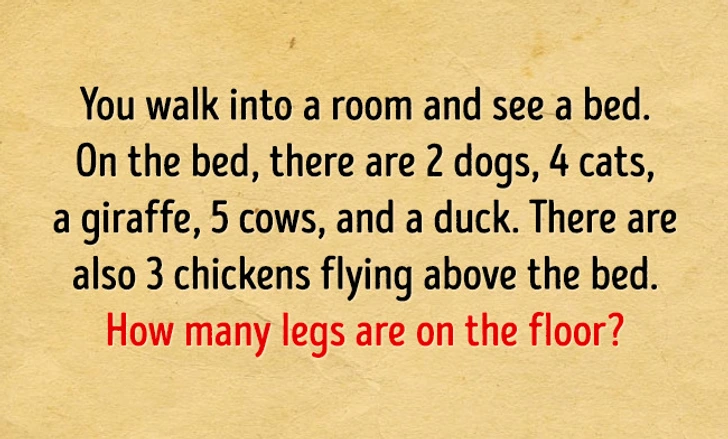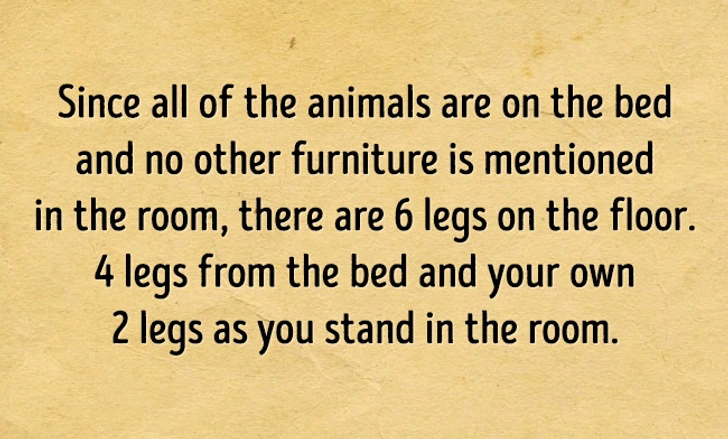Riddles are an exciting and stimulating way to challenge your brain and enhance your problem-solving skills. At first glance, they may appear straightforward, but often they require deeper thinking, which can make you second-guess your initial response. Today, we have a particularly thought-provoking riddle for you:
“You walk into a room and see a bed. On the bed, there are 2 dogs, 4 cats, a giraffe, 5 cows, and a duck. There are also 3 chickens flying above the bed. How many legs are on the floor?”

Sounds simple enough, right? Take a moment to think before we explore the common mistakes people often make when solving riddles like this.
Initially, it’s easy to focus on the details of the animals listed in the riddle. Naturally, you might start to add up all their legs, which leads many to inflate their answer. However, the key part of the riddle is: where are these animals located?
Common Mistake 1: Counting All the Animal Legs
The riddle specifies that all the animals are on the bed. This is crucial! None of the animals are on the floor, so their legs don’t count towards the final answer. Most people miss this and immediately start calculating the total number of animal legs.
Common Mistake 2: Overthinking the Chickens
Another trap involves overthinking the chickens. Since the riddle mentions the chickens are flying above the bed, many start to wonder whether their wings or legs should be counted. But remember: the riddle is asking for legs on the floor, not in the air or on the bed. Therefore, the chickens do not factor into the equation.
Let’s carefully break down this riddle step by step.
- You walk into a room – This means you, the reader, are standing on the floor. As a human, you have two legs. We start with 2 legs.
- You see a bed – The riddle does not mention any other furniture. Hence, we assume the bed is the only furniture in the room. Most beds have four legs. Adding these to your count gives us 6 legs total.
- The animals – The riddle states that all the animals (dogs, cats, giraffe, cows, duck, and chickens) are either on the bed or flying above it. This clarifies that none of their legs are on the floor, so their legs don’t count.
- What remains? – The only things on the floor are you and the bed, adding up to a final count of 6 legs.
When we analyze all the clues, the answer is clear: the bed has four legs, and you have two legs, making the total number of legs on the floor 6.

This riddle perfectly illustrates how easy it is to be misled by unnecessary details. The animals, despite being a focal point initially, do not contribute to the final answer because they are either on the bed or flying above it.
Did you guess correctly, or did the animals distract you? These riddles are enjoyable because they force you to think outside the box and question your initial assumptions. Comment below with your first guess! And if you have a favorite riddle, share it with us—we’d love to hear it.
Riddles are not only entertaining; they also help sharpen your logical thinking, improve attention to detail, and boost brainpower. The more riddles you solve, the more adept you become at approaching problems from various angles.
Why not challenge yourself with more riddles? Whether it’s a brain teaser like today’s or a classic puzzle, riddles can keep your mind agile and your thinking versatile.
An effective riddle doesn’t just make you think—it challenges your assumptions and focuses you on what’s important. As we saw with this riddle, the trick was in the details. By breaking it down, you realized the non-relevance of the animals and focused on the bed and your own legs.
Keep challenging yourself with more puzzles and riddles to sharpen your mind and enhance your problem-solving skills. Who knows? The next riddle might just stump you again!


